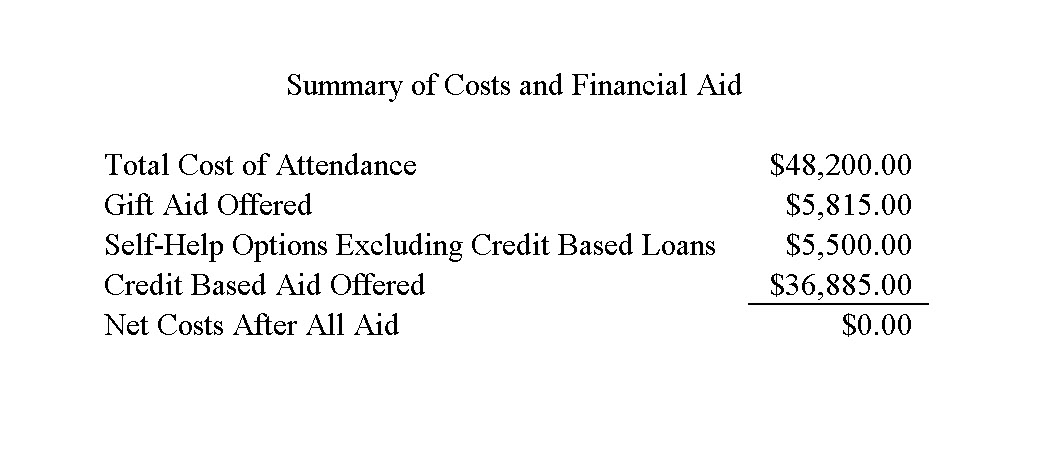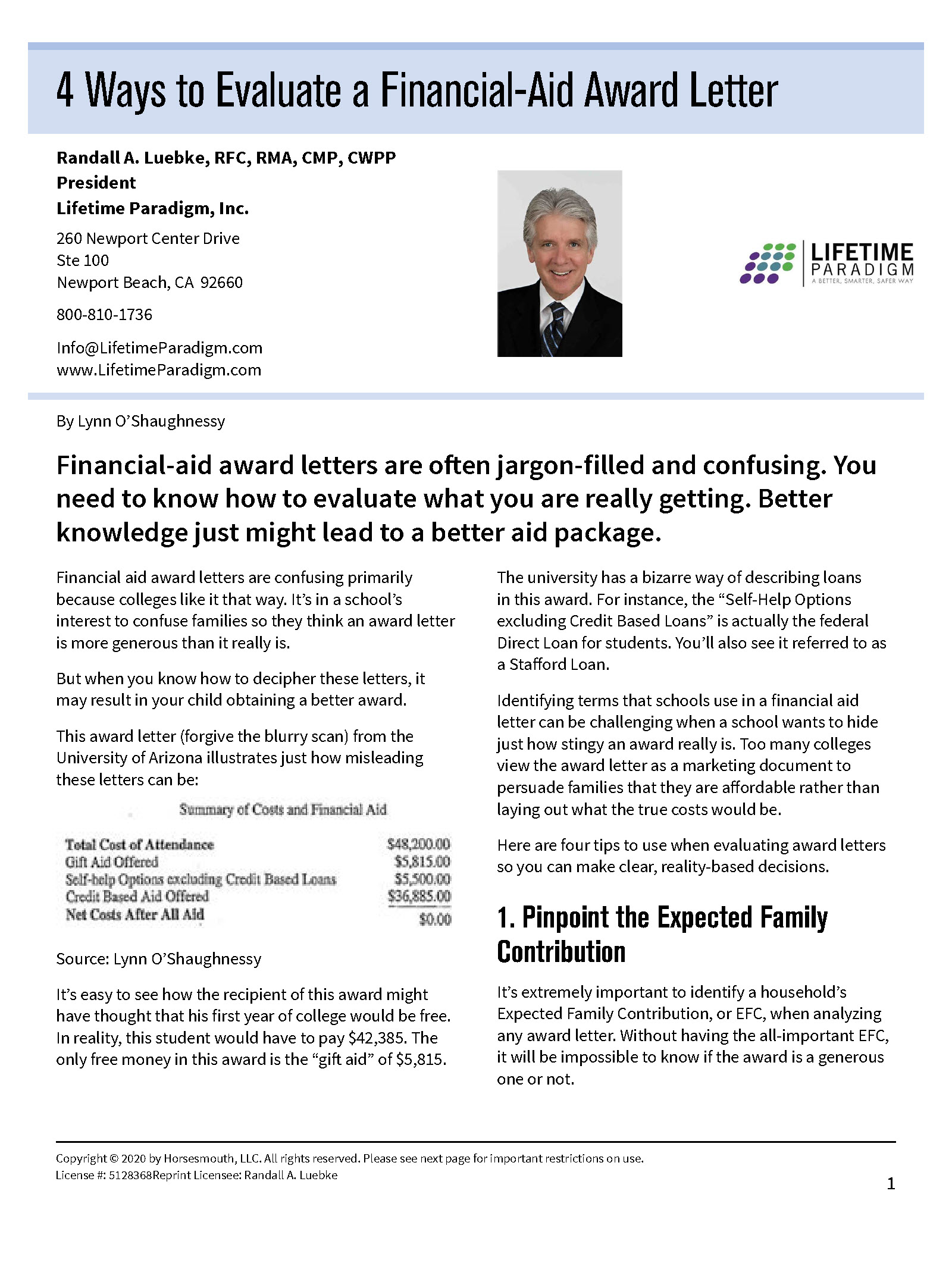Retirement Planning
4 Ways to Evaluate Financial Aid Letters
Financial-aid award letters are often jargon-filled and confusing. You need to know how to evaluate what you are really getting. Better knowledge just might lead to a better aid package.
Financial aid award letters are confusing primarily because colleges like it that way. It’s in a school’s interest to confuse families so they think an award letter is more generous than it really is.
But when you know how to decipher these letters, it may result in your child obtaining a better award.
This award letter (forgive the blurry scan) from the University of Arizona illustrates just how misleading these letters can be:

Source: Lynn O’Shaughnessy
It’s easy to see how the recipient of this award might have thought that his first year of college would be free. In reality, this student would have to pay $42,385. The only free money in this award is the “gift aid” of $5,815.
The university has a bizarre way of describing loans in this award. For instance, the “Self-Help Options excluding Credit Based Loans” is actually the federal Direct Loan for students. You’ll also see it referred to as a Stafford Loan.
Identifying terms that schools use in a financial aid letter can be challenging when a school wants to hide just how stingy an award really is. Too many colleges view the award letter as a marketing document to persuade families that they are affordable rather than laying out what the true costs would be.
Here are four tips to use when evaluating award letters so you can make clear, reality-based decisions.
1. Pinpoint the Expected Family Contribution
It’s extremely important to identify a household’s Expected Family Contribution, or EFC, when analyzing any award letter. Without having the all-important EFC, it will be impossible to know if the award is a generous one or not.
The EFC, which is generated as a dollar figure, represents what the relevant financial aid formula says the family should be able to pay for one year of college.
Example
College cost of attendance: $60,000
Institutional grant: $25,000
Direct student loan: $5,500
Excluding the student loan, the real cost to the recipient of the above award would be $35,000. Now the important question: Is this a good award or not?
You can’t possibly answer this question without knowing what the financial aid formula says the family could actually afford. In other words, you need the household’s EFC figure.
Let’s say the household’s EFC is $18,000. In this case, the award would be poor. Subtracting the EFC of $18,000 from the school’s $60,000 price tag would have ideally generated an award worth $42,000.
Nearly all schools—except for some of the most elite— would include the federal Direct Loan ($5,500) in the package for an incoming freshman, but that would still leave the family eligible for assistance worth $36,500.
2. Know where to find an applicant’s official EFC
There are three ways to identify the relevant EFC from a college.
- Ideally, the EFC will be included on the award letter. All schools should include this all-important figure, but often they do not.
- Families can obtain the federal EFC from the federal government.
When your family files the Free Application for Federal Student Aid (FAFSA), the formula generates its official EFC. All institutions will use this EFC to determine eligibility for federal and state aid. The vast majority of colleges will also use this figure when determining whether an applicant will qualify for in-house aid.
You will discover your federal EFC three to five days after filing the FAFSA electronically. That’s when you will receive a federal document called the Student Aid Report (SAR). The EFC will be displayed in the top right- hand corner of this document.
- A household’s EFC can vary for schools that also use the financial aid application called the CSS Profile. About 200 colleges, nearly all private, use the Profile information to generate its institutional EFC for a household. This EFC is used to determine which applicants will qualify for a profile school’s own financial aid dollars.
Profile colleges can personalize their aid formula by choosing from hundreds of optional questions, which means that each institution can generate a different EFC. Often these EFC figures will be quite similar, but there can be outliers.
If a Profile school does not provide the EFC on the award letter, you will have to contact each Profile institution for its EFC number.
3. Appeal based on the EFC
Once you have your relevant EFC, you can appeal an award that is a disappointing one. It’s a buyer’s market at many colleges so appealing an award that an EFC indicates is inadequate can definitely be worthwhile.
4. Consult a model financial aid award
The best way to get up to speed on evaluating an award is to use a handy cheat sheet that shows you what a model award letter looks like.
The federal government created the cheat sheet, called the College Financing Plan. Until recently, it was called the Shopping Sheet. Just Google “College Financing Plan PDF” and you will be taken to a downloadable template.
In the model letter, the EFC is prominently shared at the top. There will be no confusion about which line items are loans rather than free money.
Also importantly, the award letter shares what the family’s net price would be.
The federal government would like all schools to use the template for their award letters, but many colleges have stubbornly continued to use their own flawed ones. And that’s why it’s so important to know how to get a clear read on the aid awards you receive.
Lynn O’Shaughnessy is a nationally recognized college expert, higher education journalist, consultant, and speaker.
It’s a good life!

SERVICES WE OFFER RELATED TO THIS TOPIC
The information contained in this post is for general use and educational purposes only. However, we do offer specific services to our clients to help them implement the strategies mentioned above. For specific information and to determine if these services may be a good fit for you, please select any of the services listed below.
The Smart College Cost Eliminator ˢᵐ
Coaching and Consulting
You May Also Like…
EP 0012. The Three Generations of Annuities
The Financial Independence Now Podcast Hosted by Randy LuebkeIn Episode 12 of the Financial Independence Now podcast,...
11 Financial Tips to Make Caregiving Easier
Tax Planning Caregivers generally tend to their elderly/ disabled family members as a labor of love, but it can also...
EP 0011. Budgeting for Dummies
The Financial Independence Now Podcast Hosted by Randy LuebkeIn this episode of Financial Independence Now, host Randy...






